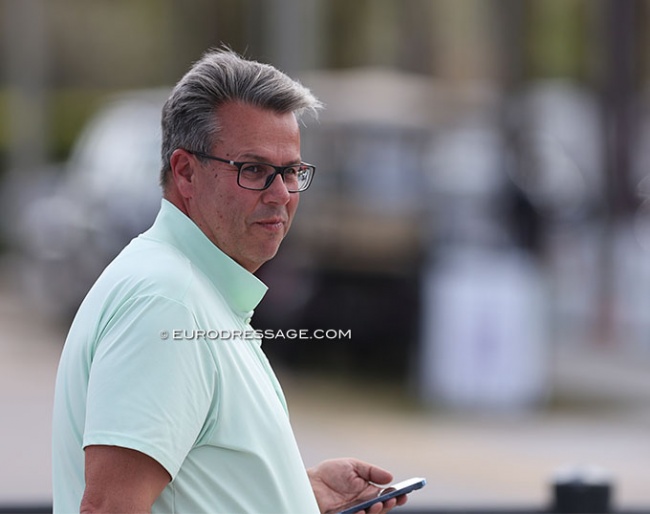
Guest columnist of this week is German Thomas Baur, show director of the Global Dressage Festival in Wellington as well as at numerous CDI's in the U.S.A. and Europe. He is the former vice chair of the International (Equestrian) Event Organizers Association (IEOA) and was a member of the FEI Dressage Committee as the show organizer's representative. He is currently a member of the European Equestrian Federation's Dressage Working Group.
Time For Change - Time For Action
The time is NOW to come together to safeguard our sport and to make a clear path for the future with the welfare of the horse as our top priority. The welfare of the horse is paramount! We need to add and amend current rules and guidelines, and more importantly, enforce them, in order to achieve this in the best way possible.
There is no time to waste. I believe that these discussions need to take place at the upcoming FEI Sports Forum at the end of April and action needs to follow. The FEI and the National Federations together with the stakeholders (Riders, Trainers, Officials and Organizers) must come up with a plan for the future of our sport.
Here is my summary of suggestions to discuss, refine and implement, as soon as possible, but ideally by January 1, 2025. I have had many, many discussions with riders, trainers, judges, stewards, equestrian journalists, vets and fellow organizers in the past few months on this subject, even before much of the recent bad publicity for our sport. I realize that not everyone will agree with these proposals.
In my opinion, these are all very important discussion points, and we need to start these discussions now.
- Welfare Supervisor
At all International Events a Welfare Supervisor must be present at the warm up/schooling rings. Stewards, national judges, former riders/trainers can join an education program created by the FEI to acquire a license to officiate at shows.
A clear system of measures taken by the supervisors needs to be established as well as an education program for the future supervisors. I want to point out that this should not add more costs for the OCs, the supervisors will be part of the existing team of Stewards.
- Welfare Collectives
Two collective marks with a coefficient of two will be introduced for all technical test (except YH 5/6yo.). Both marks are under General Impression. The first one is related to the scale of training, the second one to the harmony of rider and horse. Firewalls and clear guidelines with the horses welfare in mind needs to be developed.
- Reasons for elimination
For performances against the welfare of the horse an additional elimination rule needs to be developed. Part of that new rule would be a visible blue tongue, tongue over the bit, etc.
- Age of GP horses
The competition age for GP horses must be raised to 9yo and for competing at Championship and Games to 10yo.
- Involvement of the Stakeholders
All stakeholder clubs have to develop an action plan to increase horse welfare in their area of expertise.
- FEI Equine Ethics and Wellbeing Commission
All recommendations of the EEWG of the FEI which are approved by the FEI Board will be implemented after the Sport Forum 2024.
- Behind the vertical (BTV)
This topic has gotten completely out of hand. The outside world is jumping on each and every rider. They are all seen as guilty as charged and tarred with the same brush. We must act quickly on this topic and make very clear that there are clear differences. A rider who is repeatedly pulling or forcing the horses head down, and a horse that comes behind the vertical here and there (that a rider corrects with soft hands) are two completely different things.
Another example is in the warm up. A rider may allow the horse to stretch the muscles of his horse by lowering the neck and connecting the horse from behind, through the body, to the bit. During this process a horse may be BTV, but once again, this is very different than being ridden by a strong handed rider in a forceful way.
- Double bridle vs snaffle
This last point is a very sensitive topic and has been discussed for quite a while now. I personally believe that it should not be optional. There are many good reasons why, that have already been pointed out by people in our community. However, the argument that the double bridle may be a welfare issue is a valid point. I fully agree with Prof. Warren, Chair of the FEI Equine Ethics and Wellbeing Commission, that no one has the proof that it may be a welfare issue. However, it has also not been proven that it is not a welfare issue.
The fear is that if we make it optional, it will be used to determine and separate “good” riders and “bad“ riders (both inside and outside of our community). We have seen the first example of this already related to the optional “use of” or “no use of” the spurs.
Having said all of this, I believe an open discussion and dialogue is necessary to come to a final conclusion on these topics.
I call upon our whole community to come together now and change things for the better and the welfare of our sport and our horses. Let’s do it and let’s do it now
- by Thomas Baur
Related Links
Eurodressage Editorial: Recalibration
Thomas Baur: "Are FEI Rules Only 'Guidelines' Now?"
IDRC/IDOC/IDTC Joint Letter: "A Wake Up Call for the Vulnerability We Now Face"
Christian Landolt: "The FEI Needs to Value and Support Its Officials More"
Matthiesen's 2022 End-Of-the Year IDOC Message: "Act Like Guardians for Horse Welfare"